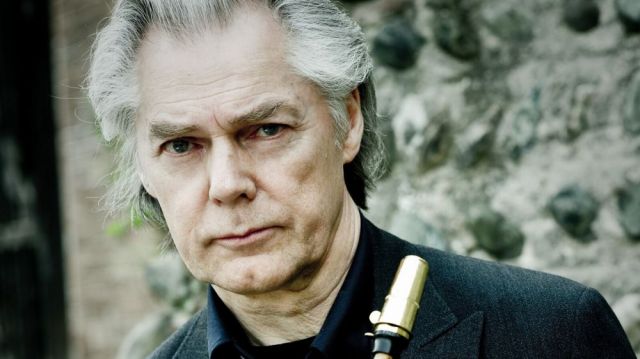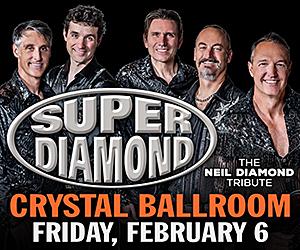Home > Jazz / Blues
05/03/2020
Bill Royston: Vivid memories of his International Jazz Days / Part 2
By BILL ROYSTON // Memories, musings and opinions from past International Jazz Days. Including Anthony Braxton in 90 degree weather wearing a heavy overcoat and a long muffler wrapped around his neck.
The Italian Instabile Orchestra, sometimes referred to simply as the Instabile Orchestra, is an avant-garde musical unit often associated for collaborations with Cecil Taylor. Under the quasi leadership of visionary clarinetist Gianluigi Trovesi, the Orchestra released "Skies of Europe," an obscure 2000 ECM album that replaces the blues vocabulary in American jazz with a blend of both jazz composition and improvisation plus European folk and classical sensibilities.
Pristinely recorded, "Skies of Europe" is not easy listening, but rather an intense music adventure that demands the listener's attention. It's in this spirit of adventure and fusion of disparate traditions that "Skies of Europe" has evolved into something of an anthem for the new European jazz movement that coincidentally started about twenty years ago and which has exploded internationally. It is New Fusion, harkening back to older days when "Fusion Was Fun," that deserves a redux on my previous take on INTERNATIONAL Jazz Day.
While "Skies of Europe" and the Instabile Orchestra are decidedly southern European (along with Italian luminaries Enrico Rava, Giovanni Guidi, and Stefano Battaglia), it's northern Europe--and especially Norway--that is the epicenter for this music. One figure, saxophonist Jan Garbarek, looms large in influencing the culture and answering the question, Why Norway? Garbarek has recorded over fifty albums since the 60's from early, Ornette Coleman/Albert Ayler inspired "Afric Pepperbird" and "Sart" (including master guitar shredder/wizard Terje Rypdal), incredibly diverse duos with Weather Report's Miroslav Vitous ( "Atmos") to the classical viola of Kim Kaskashian ("In Praise of Dreams"), groundbreaking collaborations with Keith Jarrett ("Arbour Zena" to "Sleepers"), creating arguably Europe's greatest jazz quartet with Garbarek/Eberhard Weber/Ranier Bruninghaus/Manu Katche ("I Took Up The Runes," "Visible World" and much more), to the purely classical Officum series with the Hilliard Ensemble.
Personally, Jan Garbarek is my favorite, living musician--jazz or otherwise--and I humbly assert that he is best sax player since Trane! Bold? Perhaps. Most importantly, Garbarek has now influenced two generations of younger musicians from Norway, Scandinavia, Europe, and beyond with his rich tone and the breadth of his work. His influence is felt by many musicians, not just saxophonists, in the creation of a whole new Sound. Regrettably, Garbarek steadfastly refuses to perform in North America. Believe me, I've tried! While consistently filling large European concert halls, Garbarek just doesn't like it here! So, along with visiting Royston, England and a week of MLB spring training, attending a Jan Garbarek concert (presumably somewhere in Europe) tops my Bucket List.
It's fortunate that the younger generations that Garbarek has influenced do travel well. The most prominent example is fellow Norwegian, protege, and world traveler Trygve Seim, who appeared in Portland in 2007 with his large ensemble (memorable recordings "Different Rivers" and "Sangam") and again in 2010 in a duo with accordionist Frode Haltli. Like Garbarek, Seim's tone and range on sax are breathtaking. He is the true heir apparent, as demonstrated in a stunning, recent collaboration with (American born) Norwegian guitarist Jacob Young and the Polish rhythm section headed by pianist Marcin Wasilewski under the title "Forever Young." Again, Happy INTERNATIONAL Jazz Day!
Meeting up with Trygve and his wife Asne at the Kongsberg Jazz Festival in central Norway in 2008 changed my life. Author of "The Bookseller of Kabul" and other non-fiction, Asne is both a writer and European news correspondent. As we sat by the edge of a scenic body of water that separates the village of Kongsberg into two halves, Asne peppered me with questions about Obama and whether I thought a black man could be elected President? Ironically, it was a hot (by Norwegian standards) July 4 day, but I said, No, a black man could not be elected in my racist Amerika. They both smiled and shook their heads. From afar, they had hope. They believed, and by the end of the weekend they changed my mind. About a lot of things.
In Kongsberg in the summer, the sun doesn't set. Gigs literally take place around the clock, and Trygve had a 1am performance in a 16th century cathedral on the other side of town (5 minutes away). Did I want to go? Could I stay up that late? Damn straight!
On the way, I veered to the National Mining Museum (Kongsberg is an old mining area known as 'Silver City' where Sonny Rollins wrote and first performed his Silver City Suite) to witness Dans Les Arbres, a truly avant-garde quartet under the leadership of pianist/composer/minimalist Christian Wallumrod. The subterranean room was packed and there was literally no air. No one cared. I was stunned. The music was so new, so vital. I had heard Wallumrod on earlier ECM recordings, but nothing like this... I had to meet him, but he politely put me aside and explained that he had to get ready for a 1am gig in a 16th century cathedral. Hmmmm. See you there!
We kept walking. Trygve wanted to see at least a portion of Wayne Shorter's performance on the town's outdoor plaza. Jan Garbarek may have been Trygve's idol, but Wayne was still a hero. Trygve seemed in awe that I knew Wayne. I explained that all Americans knew each other, and to prove it I took Trygve backstage. Wayne seemed genuinely stunned to find me in Norway, but he quickly turned his focus to Trygve who was carrying his sax. Later, Trygve would boast that he met Wayne Shorter, but I corrected him, "No, Wayne Shorter met Trygve Seim!" Made Trygve's day, but he was also in the process of making mine.
Again, I veered off and ended up at the old Kongsberg electrical power plant, turned into a performance space, to sit through a set with In The Country, a trio featuring pianist Morton Qvenild. I was so overwhelmed that we made plans on the spot to bring them to Portland in 2010. When they finished there was an announcement that there would be a break followed by a performance of Susanna & The Magical Orchestra. I figured it would be a long break in order to set up the 'orchestra,' so I decided to move towards the cathedral. Before I made the door, however, I spied trumpeter Mathias Eick, another of my favorite Norwegian musicians (listen to his later, Methenyesque album "Midwest"--a real classic!) who came to Portland with Trygve in 08.
After his performance, he also sat in with Dave Douglas and more than held his own. He in turn, introduced me to another scene stalwart, keyboardist Jon Balke, who I had also long admired. Before we could finish with the pleasantries, the orchestra was ready and the set was starting. Except there was no orchestra, just Morton, the amazing pianist from In The Country, and Susanna, who looked and subsequently sounded like Joni Mitchell. In reality Susanna is Christian Wallumrod's sister, singer/composer Susanna K. Wallumrod, who unlike other Norwegians I met appears to speak only broken English. Yet she sings haunting renditions of American pop standards exclusively in English (reminiscent of Irish writer Samuel Beckett writing in French to capture an eery sparseness), creating a naive sophistication that is truly mesmerizing.
Much later, when I finally reached the cathedral, Christian was outside unloading his gear for the 1am gig. I told him that I sat through his sister's show, and that she sang a song called "I Shall Sing For Free." I warned him to tell her that she shouldn't sing that song when there's a jazz promoter sitting in the front row! He laughed, and we became instant friends, which is how it came to be that Christian Wallumrod premiered his work, "Fabula Suite Lugano," in Portland in 2010.
In between leaving Susanna & The Magical Orchestra and arriving at the 16th century cathedral, there were two more stops on the junket. My Norwegian hostess kept urging me to go to the King's Hall for a special performance. "Remember," she said, " This is Silver City! " What she didn't tell me was that King's Hall was 2 1/2 kilometers inside of an abandoned silver mine. With other audience members, I adorned a hard hat and hung-on for dear life as we rode an old, rickety mining car into the mine. It took forever. I was claustrophobic, and this was really weird. When we got there, it was all black rock with lit candles strategically hung every ten feet, but you had to feel along the walls to gain passage. As I struggled, I could hear distant, reverberating Sound. In cosmic overload, I thought could this be Jan Garbarek? So stark. So Nordic! Well, almost but not quite...
We made it to the end of the dark passage way to discover the King's Hall, a large and fully equipped performance venue complete with lights, sound, and even a catering kitchen. On stage stood trumpeter Nils Petter Molvaer, a true Norwegian jazz legend from Garbarek's generation, playing solo trumpet through a bank of 6 Apple computers 2 1/2 kilometers inside an abandoned silver mine. This is where Sonny played "Silver City Suite!" It must have blown his mind! But it was Ornette who told me to capitalize the word 'Sound.' He must have also been here because Sound has a whole new meaning and purpose after hearing Nils Petter Molvaer's synthesized trumpet inside King's Hall. I realized that the King's Hall Sound is the embodiment of the phenomenon that is contemporary Norwegian jazz.
From there I somehow ended up at the Kongsberg Country Club, which as far as I could tell did not have a golf course, for a strange double bill of Super Silent, a raucous fusion band, and Anthony Braxton (who showed up in 90 degree weather wearing a heavy overcoat and a long muffler wrapped around his neck). Anthony Braxton at a country club... Over dinner! But it turned out to be Super Silent that blew me away. They were loud, very loud, and at one point I thought they would literally blow up the country club. During the break, I went up to introduce myself to the drummer, who really impressed me, but again he politely brushed me off because he was rushing to his 1am gig at a 16th century cathedral. I really wanted to catch Anthony-Braxton-at-the-
As I helped Christian unload into the cathedral, the Super Silent drummer came running down the hill. There were no drums. "Arve!" exclaimed Christian. "Am I late?" asked the drummer, " This is my fourth gig today! " The Super Silent drummer turned out to be illustrious trumpeter Arve Henriksen, who earlier had played piano in a trio with two Swedes, who he did know, then bass with some Germans that he didn't know, then drums with Super Silent, and now trumpet in a 16th century cathedral! The performance was billed as Trygve Seim/Christian Wallumrod/Arve Henriksen plus George & Christina Martens (husband and wife cellists from the Oslo Symphony), a real mouthful of a marquee for only five musicians. I was by now exhausted--having started my day by the water with Trygve and Asne pondering Obama and Amerika on the Fourth of July, then getting totally blown away musically inside an old silver mine, at a forsaken electric power plant, a funky country club with no golf course, an ancient town square, and the basement of a mining museum where there was seemingly no air--so I laid down on the back row of the church pews listening to a soundcheck with NO sound system. With saxophone, trumpet, piano, and two cellos playing with my ears in a 16th century European cathedral, I had a new appreciation for the notion of Sound along with the other-worldliness of the silver mine. I also realized for the first time that "Jazz" is far more than just being Amerika's indigenous music even if Obama becomes President. It belongs to the world!
I must have fallen asleep. A charming Japanese couple with portable recording equipment woke me. "Would you like a recorded copy of this concert?" they asked. I had met them before in Portland. They travel the world attending and recording jazz concerts, and they have impeccable taste. "You bet your ass! " I started to say, but held back remembering where I was. As we exchanged contact info, I realized that it was past midnight. I looked outside. It was still light, and people were filling the cathedral from all corners. By showtime, the room was packed. "There's more people here in the middle of the night than for Sunday services, but it's all equally spiritual," I thought. "Would an American audience support this music... At one o'clock in the morning?"
Trygve, Arve, Christian, and the two Martens were brilliant. The entire day and night were brilliant. When we finally left the cathedral after 3am, it was still brilliant outside with a light show beyond belief. Aurora Borealis? I don't know. The locals seemed unfazed, but the Japanese couple and I were having a psychedelic experience far beyond any other 4th of July fireworks. But it was the music and the Sound that had altered my reality. Even after I stumbled back to my hotel, and even later after I returned to my Amerika, I felt buoyant. I felt exhilarated, and finally just downright giddy... Especially when I got home and found that package from Japan!
First Israel and now Norway... Happy INTERNATIONAL Jazz Day!








